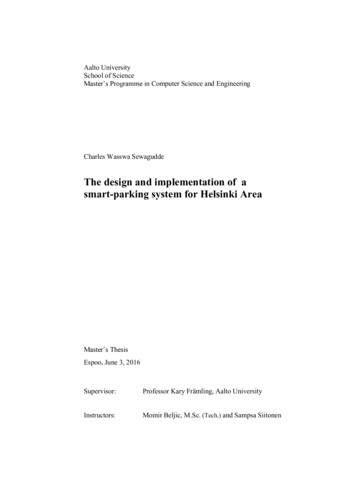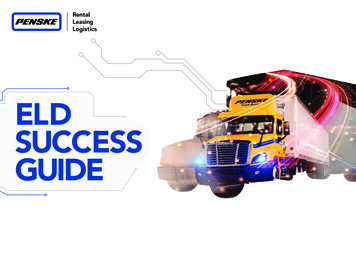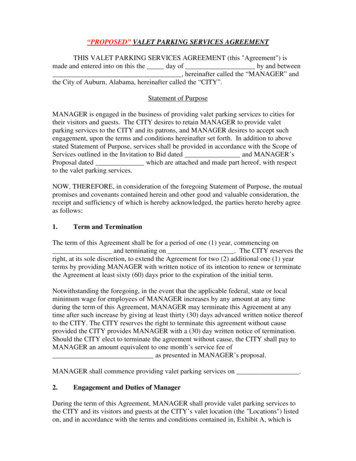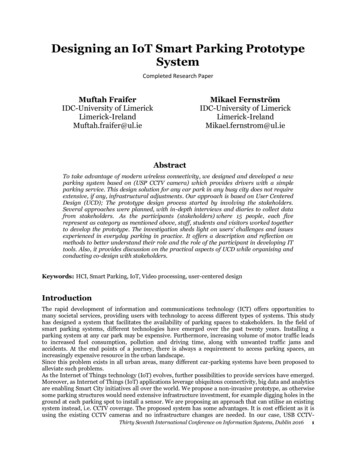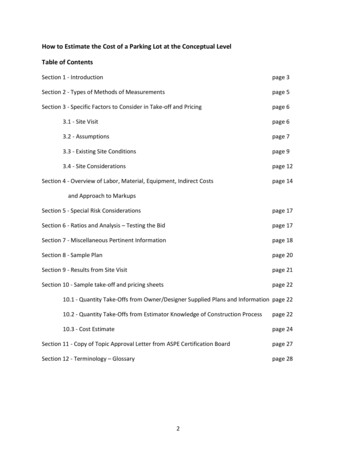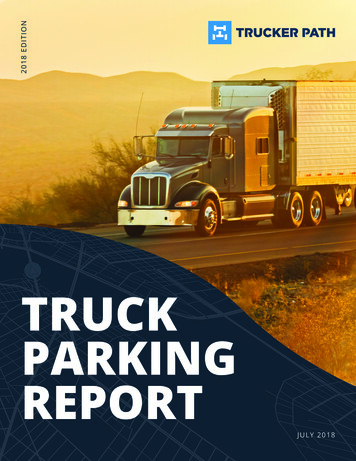
Transcription
2018 EDI T I O NTRUCKPARKINGREPORTJ U L Y 2018
T A BLE O F C O N T EN T S03 /04 /10 /12 /20 /SUMMARYPROBLEMPARKING CAPACITYOVERVIEWSOLUTIONSREFERENCESPAGE 2
SUMMARYRanked the #2 industry concern by truck drivers, thetruck parking issue has safety, social and economicconsequences. Failure to find a spot within the hours ofservice (HOS) limit puts many drivers at risk of parkingin unauthorized areas, thus making the job morestressful. In a recent Trucker Path survey, 85% of driverscited parking as the #1 cause of stress at work. 70% oftruckers have had to violate HOS to find parking and96% have admittedly parked in areas not designatedfor trucks. In addition, 48% of drivers spend an houror more finding safe truck parking, which is essentiallydriving time that is not productive time. The annualThe problem could be further resolved by helpingtruckers find or secure a spot in advance. Despite thecontroversy, truck parking reservation systems aregaining popularity with 30% of drivers reportedly usingthem. Given that such systems still cover a small fractionof overall parking capacity, they could prove to be apromising solution in the future. Today, the largestimpact could be achieved via spreading out the needfor capacity throughout the day as the vast majorityof drivers park at the same time. The United StatesDepartment of Transportation’s (USDOT) Federal MotorCarrier Safety Administration (FMCSA) is already makingloss per driver is at least 5,000. The vast majority oftruckers say it is harder to find parking after the ELDmandate and, according to Trucker Path app data, theylook up parking availability 10-15% more often duringevening hours than before the ELD mandate, signifyingadditional stress.positive changes by revising personal conveyance rulesallowing truckers extra time after the HOS limit to findparking. If listed measures don’t work, capacity couldbe expanded by utilizing weigh stations and shipperfacilities as truck parking locations. Trucker Path’s recentdriver survey shows that truck drivers find shipperfacilities almost as safe as truck stops.The issue of truck parking is widely recognized, andconsiderable effort has been applied to resolve it:truck stop chains have opened new locations, the DOTgranted public funds to build real-time parking systems,and the Trucker Path’s mobile apps helps drivers reportparking updates in real-time. These efforts may actuallybe working, as Trucker Path parking data suggests thataverage truck parking availability improved in almostevery U.S. state between 2016 and 2017. However, thereare still areas in the Eastern United States, especiallyaround urban centers, that have severe lack of capacity.PAGE 3
PROBLEMThe trucking industry is one of the most crucial parts ofthe U.S. economy. With 70% of freight moved by trucksin the US, the country heavily relies on its millions oftruck drivers.Shipping operations are complex and require differenttypes of infrastructure such as truck-ready highways,bridges, and truck parking spaces. To ensure safetyfor truck drivers as well as the traveling public, FMCSArequires drivers to take mandatory rest breaks. Duringthose breaks, drivers need to park, and finding availabletruck parking has always been difficult.Failure to find truck parking is a significant problem.According to the American Transportation ResearchInstitute (ATRI), parking is the 4th ranked concernin trucking as a whole and 2nd in the truck drivercommunity1. 48% of US truckers require an hour ormore to find an acceptable parking spot2. This lostdriving time means burnt fuel and driver wages that donot translate into fleet revenues. In addition, inabilityto find parking within the allotted daily hours of serviceputs unnecessary stress on drivers and often forcesthem to park in unsafe areas.70%Key take away:of freight is moved by trucks in the US.The country heavily relies on its millionsof truck drivers.PAGE 4
BACKGROUNDLack of available truck parking has been an issue foryears. However, major attention was brought to theissue in 2013 when Hope Rivenburg released theresults of her study regarding truck parking spaces3.Rivenburg’s husband, truck driver Jason Rivenburg, wasfatally shot in 2009 while parked at an unlit, abandonedgas station.Truck Stop chains such as Pilot Flying J and TA Petroadded parking reservation systems and openly displaythe number of available parking spots for some oftheir locations on their websites or in mobile apps. Forexample, almost 400 out of 750 Pilot Flying J locationsoffer a truck parking reservation option. TA Petro offersparking reservations for over 250 out of 550 locations4.Rivenburg’s research showed that 39% of truck driversrequired an hour or longer to find truck parking,and 83% felt unsafe while parked during periods ofmandatory rest. The study led to the passage of Jason’sWith regard to additional capacity, there is little availabledata on public rest areas. Fortunately, truck stopchains publicly disclose such information. For example,Pilot Flying J added 17 new locations in 20165, eightLaw, named for her late husband. This law resultedin USDOT releasing a memorandum clarifying theeligibility of truck parking projects for various federalfunding programs. These programs aimed to assiststates interested in advancing truck parking projectsby allowing them to use federal funding resources.The USDOT also selected two projects to provide truckparking information to drivers as part of competitive,discretionary funding programs. These projects includedone award to a coalition of eight states, which soughtfunding under the 2015 round of the TransportationInvestment Generating Economic Recovery (“TIGER”)program, and an award to the State of Florida, whichwas selected for a grant under the Nationally SignificantFreight and Highway Projects program in 2016.in 2017, and has plans to add another 20 locations in20186. These numbers don’t include renovations ofexisting truck stops that often include parking capacityexpansion. According to TA Petro’s 2017 annual report,the company added 4 locations in 2016 and 2017combined. Over the past five years, Love’s has opened147 new locations and plans to open another 40 in20187. Clearly, truck stop chains realize the need foradditional parking capacity and the economic benefits ofproviding it.In addition, private and state-funded mobile developershave created apps that display truck parking information– for example, Trucker Path and Park My Truck.Despite these efforts, the problem may have worsened.When Trucker Path carried out our Truck Parking Surveyin 2017, 40% of truck drivers reported that they neededan hour or more to find a spot. This year, the share isup to 48%. Furthermore, in ATRI’s rating of top industryissues the truck parking issue has gone up from 8thplace in 2012 to 4th in 20178.PAGE 5
ELD IMPACT2018 brought enforcement of the electronic logging device (ELD)mandate. The FMCSA requires most commercial drivers to installELDs, which automatically record drivers’ hours-of-service and dutystatus information. Because of this automation, gone are the days ofdriving a few more miles to find a parking spot and simply changingthe records. In the survey carried out by Trucker Path among 5,400drivers (see Methodology), 80% of respondents said that the ELDmakes it more difficult to find truck parking.1%According to research carried out by ATRI, drivers alreadyutilizing ELDs are nearly twice as likely to spend over 30 minuteslooking for available parking than drivers without an ELD9. This issubstantiated by the data from the Trucker Path app, which showssizeable changes in drivers’ operational planning under the newELD mandate. The average number of times a trucker looks upparking information in the mobile app has significantly increasedduring evening hours if we compare April 2017 to April 2018. Thisshows drivers feel more pressure now than before and thereforecheck parking situations more often than they did prior to the ELDmandate.The above is by no means an argument against the implementation of ELDs. Rather, the challenges with findingadequate truck parking should be considered one of the unintended consequences of ELD implementation. Nowthat drivers lack a degree of time flexibility they once enjoyed, they simply have fewer productive hours in the dayto drive. The ELD mandate adds pressure and stress to drivers and affects fleet economics, all of which ultimatelytranslate into higher rates for shippers.Average number of truck parking searches per user per hourSource: Trucker Path App2.82.62.42.22midnight4am8amApril 2017noon4pmApril 20188pmPAGE 6
IMPLICATIONSThe lack of available truck parking has social, economic and safety implications. The social and safety consequencesare heavy enough to consider this problem a top priority. The economic problems are primarily incurred by fleetsand mainly stem from reduced productivity due to loss of driving time.SOCIAL IMPLICATIONSA truck driver’s job is inherently stressful. Stressorsinclude spending a lot of time away from home andfamily, dealing with tough schedules and suffering fromchronic, debilitating illnesses associated with sitting inthe cab most of the day -- just to name a few. Failing tofind truck parking adds to the overall stress truck driversendure on the job. It is fair to assume that somethingas critical as truck parking should be readily available.However, the reality is quite different. Stress is one ofthe primary reasons drivers quit the profession, whichcompounds ATRI’s #1 and #3 top issues for trucking: thedriver shortage and driver retention, respectively.Given that there are roughly 2 million heavy haul truckdrivers in the U.S.10 (short haul drivers aren’t affectedas much by the lack of parking), eliminating the parkingchallenges would definitely have a visible positive impacton the industry. It could also help alleviate the drivershortage, as fewer drivers would leave the professiondue to high stress levels.A 2018 survey conducted by Trucker Path revealed that85% of respondents cited truck parking as the biggestcause for stress at work. The second biggest cause isHOS regulations and ELDs which require drivers to park,thus directly contributing to the amount of stress thatstems from the lack of truck parking. 7 0% of truckers have violated HOS rules because theyfailed to find truck parking 96% of drivers have parked in unauthorized areasdue to failure to find parking 84% feel unsafe when parked in unauthorized areasThe stress is caused by forcing drivers to choosebetween two less-than-optimal options: either violatethe HOS regulations or park in unauthorized areas.According to the Trucker Path survey:Please select the things thatcause stress at workRespondents were allowed to pick multiple answer choices.PAGE 7
IMPLICATIONS(continued)SAFETY IMPLICATIONSThe shortage and difficulty associated with finding legalparking creates unsafe scenarios for truck drivers andthe motoring public. Truckers who have exhausted theirallowable driving time without finding proper parkingare often forced to park on highway on and off-ramps,along the shoulders of highways and even at abandonedcommercial locations -- as was the case with JasonRivenburg that resulted in Jason’s Law. When truckspark on shoulders or ramps, not only do they posea safety risk for other motorists using the ramp, butmaneuvering in-and-out of traffic after the rest periodalso poses significant safety risks. Accidents involvingtrucks parked on shoulders and ramps have involvedinjuries, and unauthorized parking has even resultedin fatalities.Trucker Path Survey: Do you park in these unauthorized areas?PAGE 8
IMPLICATIONS(continued)ECONOMICS IMPLICATIONSFleets tend to operate on very thin margins and striveto utilize the available driving hours of their truckers asmuch as possible. Every lost hour is wasted fuel, lostwages, and missed revenue opportunity. However, our2018 survey shows that 48% of drivers spend an hour ormore per day looking for parking.An hour of driving time spent looking for parking ratherthan getting to the destination incurs variable coststhat do not contribute to any revenues. According toATRI, driver wages, fuel, trailer lease, maintenance, andinsurance accounted for about 54 per hour in 2016.11With the average of ten trips per month, a driver wastesabout 500/mo on searching for available parking.Based on this, twelve months a year equals 6,000 perdriver. For a fleet of 1,000, that’s 6 million dollars ofunproductive driver time each year.ATRI estimates the lost income to be 5,000 per truckerannually.12 This estimate is more conservative than wehave calculated, but it still leads to the same conclusion– each year the industry is losing billions of dollars dueto the inefficiencies caused by the lack of truck parking.Take 5,000 per trucker per year, with 48% of 1.9million long haul truck drivers losing an hour of drivingtime, this number translates into almost 5 billion peryear, which is 0.5% of the total transportation costs.While 0.5% doesn’t seem like a big number, at themacroeconomic scale it is significant.HOS violations can be costly as well. HOS fines rangefrom 150 to 16,000, and an accumulation of these canlead to a decrease in a drivers “safety history” leadingto higher insurance rates, reduced attractiveness tocarriers and shippers and even license suspension. Dueto the lack of safe parking, drivers are often forced topark at unauthorized locations that are not monitored.In our recent survey, 19% of truck drivers said theirpersonal belongings have been stolen from their truckwhile parked. Unsafe parking has also contributed totheft-related revenue losses for fleets. According toCargoNet in 2015, cargo theft loss was estimated to beover 173 million.13PAGE 9
PARKINGCAPACITYOVERVIEWBelieved by many to be the most comprehensivedatabases of truck parking locations, the TruckerPath app lists around 11,000 locations with multipleovernight parking spots for semi trucks in the UnitedStates. Over 9,000 of these locations are dedicated truckGeographically, truck parking capacity is unevenlydistributed with the majority of spots and locationsalong the highways and major corridors. The easternpart of the United States has a larger share of spaces,and the biggest concentrations of spaces are aroundparking locations (truck stops and rest areas), whilethe remaining are unconventional truck parking placeslike weigh stations, commercial shopping centers, truckscales, etc. The estimated truck parking capacity in theUnited States is around 330,000 individual spots, withthe majority of spaces at truck stops (274k) and restareas (43k).urban areas, for example Chicago or Dallas. See thefollowing heatmap for reference.PAGE 10
PARKINGCAPACITYOVERVIEW(continued)Used by 750,000 unique truckers monthly, the TruckerPath app requests truck drivers to report parkingavailability in real time and, in that way, helps driversfind available parking. Parking availability can bereported with three statuses: the stop is “full”, thereare “some spots” or there are “many spots” available.According to our user survey, 97% of drivers find theupdates reported by other drivers in the Trucker Pathapp reliable for finding a spot. The truck parking featurewas introduced three years ago by Trucker Path, andsince then we have gathered tens of millions of datapoints. Such crowdsourced data collected over timehelps us understand average parking availability at mosttruck stops at any given time.When compared between the summers of 2016 and2017, the data from the Trucker Path app shows that,on average, the truck parking availability across theUnited States slightly increased. Hundreds of thousandsof truckers using the app reported more available spotsat night in most US states in 2017 than in 2016. Theonly three states where the parking situation got worsewere Delaware, Massachusetts and Oregon. However,the negative changes were less than two percentagepoints in terms of overall available parking at night andtherefore could be considered a statistical error. Such aconclusion is surprising, because many drivers believethat the situation has become worse; however, thesesame drivers on average report a higher availability inthe Trucker Path app at night. The average capacity perstate does not really mean that every individual drivercan find a spot because they wouldn’t drive across thestate to a location that has free spaces. Nevertheless,the conclusion that the share of available parking atnight has slightly increased may indicate that the issue ismore about the perception and ability to find spots thanthe actual lack of capacity.PAGE 11
SOLUTIONSDrivers and experts mention the lack of capacity andinformation availability as the primary reasons for thetruck parking issue. Even when there is an available spotnearby, some drivers struggle to find parking becausethey are unaware. But oftentimes, all the nearby restareas and truck stops are full, so the options a driveris left with are unfavorable. The solutions come downto two groups: first – better utilize the existing parkingcapacity, and second – expand parking capacity.UTILIZINGEXISTING CAPACITYDriver BehaviorThere are many ways for drivers to ensure theyefficiently plan their route to park their truck by thetime they hit the HOS limit. It turns out most driversalready do their best to find truck parking; however,we identified that some drivers could do better. 61% ofsurveyed drivers already plan for truck parking duringthe trip. That leaves 39% who check truck parking infoonly before hitting the HOS limit.Another way to be successful in finding a spot is to startlooking an hour before the HOS limit. Given the ELDmandate, there is no flexibility in surpassing the limit,which means drivers may have to sacrifice driving time.Notwithstanding the above, most would agree that it isbetter to have no violations and be less efficient than touse all driving hours and park in an unauthorized area.89% of drivers surveyed reported starting to look anhour or more before hitting the HOS limit -- indicatingthere is likely very little drivers themselves can do toimprove the situation.PAGE 12
SOLUTIONS(continued)UTILIZING EXISTING CAPACITYInformation SystemsAnother significant factor preventing drivers fromfinding parking fast is the lack of information. Thisfactor can be broken down into two parts: having thetechnology in place to track available parking and,in turn, disseminating that information. At TruckerPath we have seen progress in giving drivers the toolsto access information, primarily via mobile apps. Inaddition, some states have added dynamic displaysalong highways for the same purpose. However, thequality of that information needs improvement.Today, most drivers primarily rely on crowdsourceddata from other drivers disseminated via mobile apps.Our survey shows that 78% of drivers who have TruckerPath use it to find parking. Of those who use the truckparking search feature, 97% find the informationhelpful in finding a spot. Despite the effort, havingmore accurate, constantly available updates wouldmake the truckers’ lives easier.Truck stop chains such as Pilot Flying J and TA Petrohave put in place information systems that list the exactnumber of available spots at some of their locations.However, these are available only at a fraction of alllocations. The information is displayed in truck stops’proprietary mobile apps, which makes sense for thechains but is not convenient for drivers because theyhave no single view of all available spots nearby. Thenext step in improving the situation is sharing parkinginformation with independent app developers.PAGE 13
SOLUTIONS(continued)UTILIZING EXISTING CAPACITYParking ReservationsIf a driver consistently fails to find truck parking beforethe HOS limit, another way to solve this problem is toreserve truck parking in advance. Parking reservationsare a good strategy to ensure that a particular truck canpark at night, but this only has to do with the allocationof spots and doesn’t solve the capacity problem. At thesame time, it helps drivers avoid redundant stress atwork.Currently, only a few major truck stop chains offerparking reservation options. For example, Pilot FlyingJ’s Prime Parking allows drivers to reserve a spot at 400out of 750 of its locations for up to 12 hours for 1220. TA Petro offers a similar service for 250 out of 550locations and allows drivers to book a spot up to 30days in advance.However, paid parking reservations are somewhatcontroversial. Our survey shows that 53% of therespondents have a negative view on parkingreservations. At the same time, 33% of the surveyedhave a neutral view, while 14% have a positive opinion.Even though truck parking reservations are notavailable everywhere, they are used by 30% of truckdrivers. The biggest hurdle to further adoption is theprice. While 15% of fleet drivers said that their fleetpays for reservations, most drivers are not ready to payout of pocket.At the same time, few if any smaller truck stops have atruck parking reservation option. According to Roady’sCEO Matt Patterson, truck stops recognize the value insuch a system but face operational and implementationchallenges. There is no readily available solution thatcould be easily adopted by truck stop owners. When atruck stop chain like Pilot Flying J makes the decisionto introduce parking reservations, there is a dedicatedgroup of people taking care of the R&D, and its locationmanagers implement the systems on site. However,independent truck stops lack such a level of resourcesand therefore lag behind in introducing a similarsystem.In conclusion, information systems have progressedwithin the past several years. If independent truckstops participate, that would create a positive impact.Parking reservations appear to be the economicincentive to develop information systems for trackingparking availability, although drivers aren’t excited.With drivers unwilling to pay, truck stops aren’tincentivized to put in extra effort that will not becompensated. A solution to this could be truck stopsallowing the use of parking reservation payments asstore credit. However, it is up to the market to decidethe pricing.PAGE 14
SOLUTIONS(continued)UTILIZING EXISTING CAPACITYHOS FlexibilityAccording to our survey, 65% of drivers look for parkingbetween 6pm and midnight. This is further supportedby the usage of Trucker Path’s Truck Parking Searchfeature (see below). Many drivers parking at the sametime creates a peak demand for spaces and, given thatthe supply (capacity) is fixed, there are not availablespots for all the truckers.If so many drivers didn’t have to park at the same time,finding a parking spot could be done more easily. Thatsaid, shipper operations and HOS requirements areconstraining factors for drivers that cannot be ignored.Industry data shows 75% of drivers are detained ata pickup or delivery site for two or more hours everyweek, and 35% are delayed more than six hours everyweek.14 Drivers getting detained at the shipper losetime and eventually rush to either find truck parking ordrop off the shipment. Not only does that create stress,it also poses safety concerns.With the adoption of ELDs, it is now easier to trackdetention time. Therefore, one can see when a driverwas detained. Some have proposed an “extendeddetention exception” to lengthen the 14 hour on-dutylimit by two hours if a driver has been delayed morethan two hours. Such a measure would not only easesome driver stress, but also widen the driving windowand even out the demand for parking during the day.Now that tracking wait time at the shipper is easier,detention fees could incentivize some facilities toeither be more efficient and load more quickly orallow for flexibility in pick-up and drop-off times. Thatadjustment could also positively impact the demandcurve for truck parking.On May 31, 2018 FMCSA published new rules thatallow drivers to use their “personal conveyance” timeto find safe truck parking if a shipper or receiver hasexhausted driving hours, even when the vehicle is“laden”. This is definitely a positive thing for truckdrivers, as they will have more time to find a parkingspot instead of resorting to unauthorized parking.How Many Unique Users are Using the Parking SearchFeature in Trucker Path per Hour?Weekdays, April-May 2018Usage at 12pm 100%PAGE 15
SOLUTIONS(continued)UTILIZING EXISTING CAPACITYExpanding CapacityThe solutions mentioned thus far could improve thetruck parking situation in many regions. However,there may still be areas that require additional parking.Building new capacity is expensive and difficult. Aspreviously stated, the need for parking capacityis dynamic, so many different factors need to beconsidered before building additional parking capacity.Essentially, capacity expansion could be achieved intwo ways: converting/utilizing existing capacity thatis currently not used for truck parking and capitalinvestment in new parking spaces.When choosing the best approach, it is important tounderstand what drivers prefer and where they feelsafe. Not surprisingly, the most preferred truck parkinglocations are truck stops, followed by public rest areas.PAGE 16
SOLUTIONS(continued)UTILIZING EXISTING CAPACITYWeigh StationsAs we can see from our data, at least 5,000 parkingspaces are available at 400 weigh stations. Given thatthere are over 1,600 weigh stations in the US, thereis likely additional capacity with those weigh stationsthat could be further explored. At the same time,additional considerations must be made before allowingovernight parking at weigh stations, because they arenot a preferred parking location for 68% of surveyedtruck drivers and are considered to be unsafe by 23% ofsurvey respondents.Shipper FacilitiesAccording to our survey, 85% of drivers said thatshippers sometimes allow parking on their premises.Given that drivers feel almost as safe at the shipperas at a truck stop, making shipper parking a normcould significantly help solve the problem. This, ofcourse, would require carriers and shippers to start aconversation and try to find a win-win solution whereboth parties benefit when a trucker can utilize shipperfacilities for overnight parking.Shopping CentersShopping centers can be an alternative source forovernight truck parking spaces. The Walmarts thatallow overnight parking are listed in Trucker Path andrepresent almost 6,000 spaces nationwide. A win-winsolution could likely be discussed between commercialstores and FMCSA to increase the available capacity.On the other hand, 26% of drivers consider shoppingcenters to be unsafe, so additional considerations mustbe made.PAGE 17
SOLUTIONS(continued)UTILIZING EXISTING CAPACITYBuilding New CapacityTruck stops and rest areas are conventional parkinglocations, so they’re naturally the preferred options fortruck parking. In case existing capacity is not sufficienteven if all the above measures have been taken, newspaces must be built.results. According to drivers, it is harder to find truckparking in the eastern part of the US. In addition, 51% ofrespondents said that urban and rural areas are equallybad for finding parking, and 45% said that urban areasare worse.As we have discussed, the eastern United States needstruck parking the most. When deciding where to buildnew capacity, it makes sense to look at the existingsituation in the form of a heatmap (see below). Theinformation on the map is consistent with surveyExpanding truck parking capacity is one of the mostobvious solutions to the problem. At the same time,it can be capital intensive and therefore needs tobe strictly prioritized, taking into account return oninvestment and geographical demand.PAGE 18
METHODOLOGYTRUCK PARKINGCAPACITY HEATMAPTrucker Path is America’s most popular app for truckerswith nearly 750,000 truck drivers as active users. Themobile app is used to find truck stops, check dieselprices, find available truck parking, and more. TruckerPath allows truck drivers to report parking availability ata location in three statuses: “Lot is full,” “Some spots,”“Lots of spots.” Trucker Path users contribute more than1,000,000 parking status updates a month, with mostof the updates happening during evening hours. Toanalyze the lack of capacity, we combined the data fromtwo periods: May 1, 2016 – August 31, 2016 and May1, 2017 – August 31, 2017. We only looked at summermonths, as this is when the demand for truck parking isthe highest. In addition, weekends were excluded fromthe analysis, as this is when the parking situation is lessproblematic. We considered only night hours (i.e., 11pmto 5am) – when most trucks are parked. A lot of smallerlocations were excluded due to the lack of statisticallysignificant amounts of data at those locations. Havinglimited the scope, we calculated the likelihood as aweighted average of different updates. “Lots of spots”was appointed 100% probability, “Some spots” 25%, “Lotis full” 0%. A 15% value would mean that there is 15%likelihood that a truck stop has a free a spot at nightduring weekdays.SURVEYBetween May 8 -15 of 2018, over 5,500 truck driversparticipated in a survey about the truck parking issuein the US. The questionnaire consisted of 26 questionsand was distributed via the Trucker Path apps. Whenpresenting the conclusions of this survey, we limitedthe response sample only to those drivers who do notreturn home every night, and for the sake of diligence,certain questions were limited to a specific audience. Forexample, owner-operators’ responses were excludedfrom fleet-related questions.ABBREVIATIONS& ACRONYMSDOT – Department of TransportationFMCSA – Federal Motor Carrier Safety AdministrationHOS – hours of serviceELD – electronic logging deviceATRI – American Transportation Research InstituteTIGER – Transportation Investment GeneratingEconomic RecoveryPAGE 19
REF EER
The issue of truck parking is widely recognized, and considerable effort has been applied to resolve it: truck stop chains have opened new locations, the DOT granted public funds to build real-time parking systems, and the Trucker Path’s mobile apps helps drivers report
